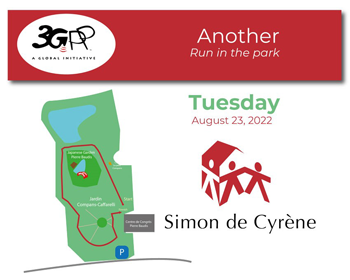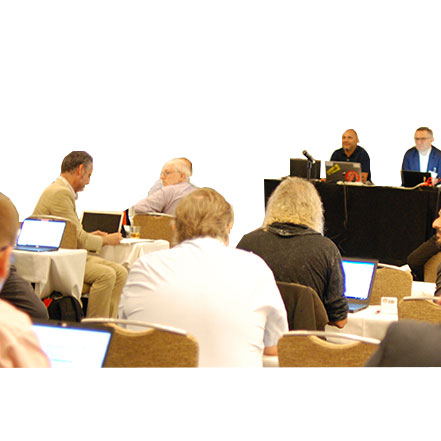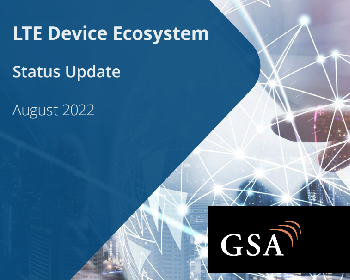3GPP RAN: Rel-12 and beyond
Dino Flore, 3GPP RAN Chairman, February 2014
3GPP RAN (Radio Access Networks) has started a new innovation cycle which will be shaping next generation cellular systems. The work spans a variety of new technology areas, which are briefly described in this article.
LTE: capacity and cell-edge performance improvements
In order to meet the growing mobile data demand, 3GPP is looking at a variety of technologies that will improve network capacity and cell edge performance of LTE networks. The key focus here is on network hyper-densification, as it is generally agreed that this approach can deliver significant capacity gains.
 3GPP started working on Small Cells (low-power nodes) in Release 8, with focus on residential or enterprise use for a Closed Subscriber Group of users. But with Release 12 it is taking the use of Small Cells and network densification to a whole new level in order to achieve the desired capacity gains. This includes the development of a number of radio and protocol solutions that are aimed at improving spectral efficiency and operation when the density of small cells increases.
3GPP started working on Small Cells (low-power nodes) in Release 8, with focus on residential or enterprise use for a Closed Subscriber Group of users. But with Release 12 it is taking the use of Small Cells and network densification to a whole new level in order to achieve the desired capacity gains. This includes the development of a number of radio and protocol solutions that are aimed at improving spectral efficiency and operation when the density of small cells increases.
To improve spectral efficiency a higher-order modulation scheme is being added to the downlink operation (i.e. 256 QAM), while Small Cells discovery mechanisms are being studied allowing the network to efficiently switch on/off cells in order to maximize its capacity. Another key feature is Dual Connectivity allowing terminals to connect to two cells simultaneously. This for instance could be used to anchor connections to macro cells while boosting datarate via Small Cells. For LTE TDD (Time Division Duplexing) networks, robust interference management techniques are being looked at for the case when neighbor LTE TDD cells have different uplink/downlink resource allocations to better adapt to varying traffic conditions in different cells.
While essential for LTE TDD networks, synchronization has become increasingly important for LTE FDD (Frequency Division Duplexing) networks as well in order to implement some of the advanced interference management and multi-point coordination schemes developed in Rel-10 and Rel-11 (namely eICIC, Enhanced inter-cell interference coordination and CoMP, Coordinated Multi-Point). Synchronization can be quite challenging for Small Cells due to their location and non-ideal backhaul, and operators may not rely on traditional synchronization schemes such as GPS and backhaul mechanisms. To address  this issue over-the-air synchronization schemes are being studied.
this issue over-the-air synchronization schemes are being studied.
Finally, as hyper-dense networks will pose new challenges in terms of mobility management and network planning, 3GPP is looking at mechanisms to optimize mobility and to automate network planning and optimization for Small Cells.
To further enhance the spectral efficiency and cell edge performance of LTE networks, 3GPP is looking at enhancements of MIMO (Multiple-Input, Multiple-Output), CoMP and advanced interference suppression mechanisms standardized in previous releases. A 3D channel modeling study is ongoing to enable future work on terminal-specific Elevation Beamforming and Full-Dimension MIMO (MIMO systems with large number of antennas, e.g. 64 x 4, which will become relevant with the use of higher frequencies in the future). CoMP enhancements are being discussed for the case when cells are connected via a non-ideal backhaul, which is particularly relevant when Small Cells are employed in multi-point coordination schemes. Finally, the group is evaluating advanced interference suppression techniques at the terminal, including support of interference suppression on the data channel, with and without network assistance.
LTE: making more spectrum available at the terminal
Operator demand for more spectrum aggregation remains quite high, primarily to be able to fully utilize their often fragmented spectrum holdings and deliver higher data rates to the users. This has led to some advancements of the Carrier Aggregation (CA) technology: while the group is finalizing the RF requirements specification of 2 downlink / 1 uplink CA combinations, new work is being planned on 2 downlink / 2 uplink as well as 3 downlink / 1 uplink CA combinations.
 As many operators around the world own paired (FDD) and unpaired (TDD) chunks of spectrum, it should not come as a surprise that 3GPP has started working on a framework that will allow operators to aggregate FDD and TDD carriers.
As many operators around the world own paired (FDD) and unpaired (TDD) chunks of spectrum, it should not come as a surprise that 3GPP has started working on a framework that will allow operators to aggregate FDD and TDD carriers.
More and more 3GPP operators are using unlicensed spectrum for traffic offloading, and this motivated the ongoing evaluation of radio solutions for steering terminals between LTE/UMTS and WiFi. The goal here is to improve inter-working between the two systems in terms of mobility and load balancing capabilities.
LTE: new service enablers
One important area of work is on solutions optimizing LTE operation for low datarate, delay tolerant, Machine- Machine-Type Communications (MTC). A number of radio solutions are being considered in order to reduce modem cost of MTC devices, including a new low datarate User Equipment (UE) category, 1-receive antenna operation, narrowband data channel operation and half duplex operation. Receiver, repetition and bundling techniques are instead being considered to extend the coverage of control and data channels. MTC signaling enhancements are also being discussed in order to optimize power consumption and reduce signaling overhead. This includes the introduction of a new power-saving state for MTC devices as well as the introduction of assistance information about the terminal and its traffic pattern, to help RAN nodes to configure connections accordingly.
Another feature being developed for the LTE system is Device-to-Device (D2D) communication, which will enable a number of new Public Safety and consumer usecases and business opportunities. In particular 3GPP is designing solutions that will allow terminals to discover and communicate with each other under network supervision, and in some cases even without network supervision as for some Public Safety usecases where terminals will be outside network coverage.
 Work in ongoing on Group Communication, which together with D2D is the other key enabler of many Public Safety usecases. Here the goal is to evaluate the suitability of the LTE radio interface for Group Communication.
Work in ongoing on Group Communication, which together with D2D is the other key enabler of many Public Safety usecases. Here the goal is to evaluate the suitability of the LTE radio interface for Group Communication.
New eMBMS (evolved Multimedia Broadcast Multicast Service)-related measurements will be defined so that they can be used by operators to optimize the quality of MBMS services being delivered. The new measurements will be collected using the MDT (Minimization of Drive Tests) framework standardized in Rel-10.
UMTS evolution
The UMTS system is also being evolved with a variety of new features. The main focus is on improving the system capacity and user-experience of next generation networks. Like for LTE, one of the key technology areas being discussed is the support of heterogeneous networks, with particular focus on solutions that address mobility and interference issues in case of network densification.
In the past few years, HSPA (High Speed Packet Access) networks have experienced a considerable increase in number of users and traffic, both in downlink and uplink. While in recent releases a variety of techniques have been standardized to improve the downlink performance of HSPA networks, 3GPP is now working on uplink enhancements that improve capacity and coverage of uplink operation. This includes overhead reduction, datarate boosting, enhancements to access control and optimized Transmission Time Interval (TTI) switching.
Dedicated channel (DCH) remains the main over-the-air transport option for Circuit-Switched (CS) services in UMTS networks. This motivated the work on DCH enhancements such as removal of pilot overhead and support of Early Frame Termination. These enhancements can significantly improve dedicated channel capacity when supporting CS voice services, something particularly suitable for emerging markets.
CA advancements are also being planned for UMTS. In particular, one novelty for UMTS is the RF requirements definition of a first Supplemental Downlink CA combination, which will allow operators to employ one TDD carrier as a supplemental downlink carrier for FDD operation.
Another interesting feature being evaluated is Scalable UMTS, which enables UMTS operation in channel bandwidths smaller than 5 MHz, e.g. 2.5 MHz. The feature can be useful for operators that own fragmented chunks of spectrum and to facilitate re-farming of GSM spectrum to UMTS.
Conclusion
In this article we provided a brief overview of the radio technology enhancements being developed by 3GPP for next generation LTE and UMTS networks. These technologies will help address the explosive mobile data growth as well as enable new services, thus meeting the evolving demand of cellular operators and their customers.
LTE/UMTS evolution – a brief history;
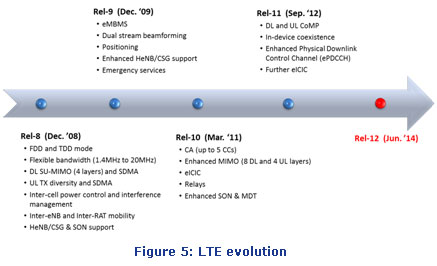
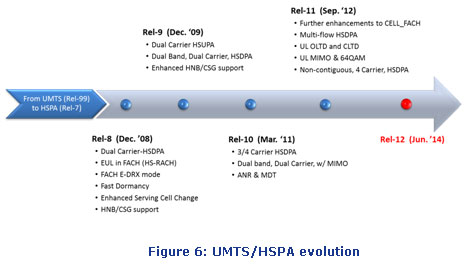
Further Reading:
- Heterogeneous Networks in LTE by 3GPP experts
- Future Mobile and Standards for 5G including a video of Dino Flore's presentation on the RAN in R12 and beyond
Contact for this story:
Kevin FLYNN
Note: 3GPP Officials, including Dino Flore, will be speaking at Mobile World Congress.

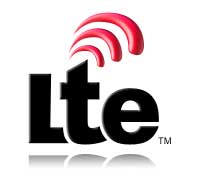
 3GPP News
3GPP News